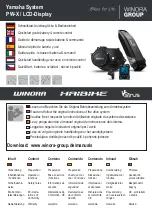
38
In most cases a fatigue crack is not a defect. It is a sign that the part has been worn out, a sign the part has
reached the end of its useful life. When your car tires wear down to the point that the tread bars are
contacting the road, those tires are not defective. Those tires are worn out and the tread bar says “time for
replacement.” When a metal part shows a fatigue crack, it is worn out. The crack says “time for
replacement.”
Fatigue Is Not A Perfectly Predictable Science
Fatigue is not a perfectly predictable science, but here are some general factors to help you and your dealer
determine how often your bicycle should be inspected. The more you fit the “shorten product life” profile, the
more frequent your need to inspect. The more you fit the “lengthen product life” profile, the less frequent
your need to inspect.
!
Factors that shorten product life:
•Hard, harsh riding style
•“Hits,” crashes, jumps, other “shots” to bike
•High mileage
•Higher body weight
•Stronger, more fit, more aggressive rider
•Corrosive environment (wet, salt air, winter road salt,
accumulated sweat)
•Presence of abrasive mud, dirt, sand, soil in riding
environment
!
Factors that lengthen product life:
•Smooth, fluid riding style
•No “hits,” crashes, jumps, other “shots” to bike
•Low mileage
•Lower body weight
•Less aggressive rider
•Non-corrosive environment (dry, salt-free air)
•Clean riding environment
WARNING: Do not ride a bicycle or component with any crack, bulge or dent, even a small one.
Riding a cracked frame, fork or component could lead to complete failure, with risk of serious injury
or death.
!
B. Understanding composites
All riders must understand a fundamental reality of composites. Composite materials constructed of carbon
fibers are strong and light, but when crashed or overloaded, carbon fibers do not bend, they break.
!
What Are Composites?
The term “composites” refers to the fact that a part or parts are made up of different components or
materials. You’ve heard the term “carbon fiber bike.” This really means “composite bike.”
Carbon fiber composites are typically a strong, light fiber in a matrix of plastic, molded to form a shape.
Carbon composites are light relative to metals. Steel weighs 7.8 grams/cm3 (grams per cubic centimeter),
titanium 4.5 grams/ cm3, aluminum 2.75 grams/cm3. Contrast these numbers with carbon fiber composite at
1.45 grams/cm3.
The composites with the best strength-to-weight ratios are made of carbon fiber in a matrix of epoxy plastic.
The epoxy matrix bonds the carbon fibers together, transfers load to other fibers, and provides a smooth
outer surface. The carbon fibers are the “skeleton” that carries the load.
Содержание - V8.0
Страница 1: ...VERSION 8 0...









































